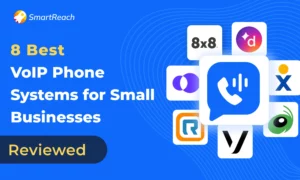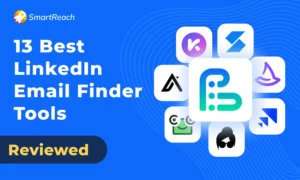Cold Email Checklist: 8 Tips for More Email Replies
Cold emailing still works if your message arrives, reads as genuine, and gives the recipient a small, useful next step.
To find some new clients or business partners, you need to send well-written text messages or emails.
This checklist is a quick pre-send audit you can run in 60 seconds for every email campaign. Use the actionable items, copy the templates, and track the metrics listed at the end.
TL;DR: How to get more email replies
- Keep the email short (≤ 5 sentences).
- Personalize the opening with a real, specific detail.
- Make subject + preview text promise and deliver value.
- Set clear, tiny CTAs (reply “yes” or a 10-min call).
- Add 2 follow-ups spaced 3–5 days apart.
- Fix deliverability: SPF/DKIM/DMARC + warm-up + verify list.
Use the cold email checklist below before you hit send.
#1. Audience fit: Are you writing to the right person?
Action steps:
- Confirm the prospect’s role aligns with your solution. Use LinkedIn, company website, and press releases to know more about the prospects.
- Look for a business context trigger (funding, hiring, launch, layoffs, promotions, acquisitions).
- Spend a max of 90 seconds per contact. If you can’t find a relevance trigger, skip that lead.
Cold emails fail when the email recipient feels like part of a spray email list. Relevance doubles response likelihood.
💡 Pro tips:
- If you sell HR tech, target “Head of People” when a company has 20+ open roles.
- If you offer SaaS for churn prevention, look for companies that recently announced funding → retention becomes critical.
- Email personalization is about context, not flattery.
- Avoid generic “I love your company.” ❌
#2. Subject line + preview: Does the promise match the email?
Action steps:
- Keep email subject lines in 4–7 words; ensure it delivers on the email’s content.
- Write preview text as a continuation, not repetition.
- Test curiosity vs value-driven styles → “Quick idea for {Company}” vs “Cut churn 18% in 3 weeks.”
The email subject line decides whether your email gets opened. Misleading subject lines hurt trust and trigger spam reports.
💡 Pro tips:
- Curiosity style: “An overlooked cost at {Company}” → preview: “I noticed X trend and wanted to share a quick idea.”
- Value style: “3 ideas to reduce {pain}” → preview: “Here’s one quick example we helped a peer achieve.”
- Run A/B tests by splitting your list 50/50 and compare open rates.
Read more: Why do misleading subject lines send emails to SPAM?
#3. Opening line: Is it specific and short?
Action steps:
- Use a single, personalized observation based on research.
- Avoid filler phrases like “Hope this finds you well.”
- Tie observation directly to recipient’s business (recent post, new hire, event, growth signal).
A strong email opener proves your email isn’t mass-sent. It shows intent and earns 5 more seconds of attention.
💡 Example of effective email opening lines:
- Keep email personalization tactical, not fluffy. Mention metrics, not hobbies.
- “Noticed you’re hiring 12 SDRs – scaling sales must be a priority.”
- “Congrats on your Forbes feature — I liked your point on remote onboarding.”
For more relevant email opening lines, check out the article “165 Email Opening Lines To Increase Engagement & Get Results“

#4. Email body length: Keep it under 5 sentences
Action steps:
- Structure emails as: context → value → proof → CTA.
- Stick to single-column, short sentences (10–12 words).
- Break paragraphs for scannability — no text walls.
Email readers skim.
70%+ of cold email replies happen when the message is ≤ 100 words.
Examples:
- Bad: “I’d love to set up a call where I can explain…” ❌
- Good: “We helped {peer} cut hiring cost by 22%. Could share one idea?” ✅
- Always write in plain language, no jargon.
Read more: How to Write Cold Email Subject Line & Body Copy?
#5. Value & credibility: Show it
Action steps:
- Use one data-backed proof point or case snippet.
- Highlight specific outcome (time saved, cost reduced, revenue gained).
- Keep it under 2 sentences.
Prospects ignore vague claims (“we’re the best”).
Specific numbers = trust.
Examples:
- “We helped {PeerCo} reduce support tickets by 35% in 90 days.”
- “Clients cut CAC by $210 on average in 2 months using our tool.”
- Use a peer in the same industry/size for stronger relevance.
#6. CTA: Make it low-friction & specific
Action steps:
- Ask for ONE simple action (reply or quick call).
- Offer 2 date/time slots for clarity.
- Frame CTAs as a benefit to them, not your need.
Ambiguous CTAs (“let’s connect sometime”) get ignored.
Clear next steps reduce decision fatigue.
Examples:
- “Open to a 10-min call Tues/Thurs afternoon?”
- “If you reply YES, I’ll share 2 tested ideas.”
- Use options, not obligations , recipients like to choose.
#7. Follow-up: Use 2–3 touches with added value
Action steps:
- Send at least 3 email follow-ups spaced 3–7 days apart.
- Each follow-up should add one new value nugget (case study, insight, article, template).
- Last follow-up: polite permission to close loop.
60%+ of replies come from follow-ups.
Persistence + value works better than one-off emails.
Examples:
- Follow-up 1 (Day 3): “Sharing 1 quick strategy we used with {peer} to cut onboarding time by 20%.”
- Follow-up 2 (Day 7): “Final note — happy to send a short checklist if useful.”
- Keep tone warm, not pushy. Never guilt-trip.
Read more: 12+ Follow Up Email Mistakes That Kill Your Response Rates
#8. Email deliverability quick check (before sending)
Action steps:
- Warm up new email inboxes for 2–4 weeks.
- Set up SPF, DKIM, DMARC.
- Test with tools like mail-tester.
- Verify email lists with verification tools to remove invalid/bounces.
- Limit daily sends per inbox (start at 30–50/day, scale to 200–300).
- Avoid spam triggers (ALL CAPS, too many links, attachments).
Even perfect copy fails if your emails land in spam.
Email deliverability = foundation.
💡 Pro tips:
- Use plain text for first touch (better inbox placement).
- Rotate inboxes if scaling campaigns.
- Monitor bounce rate (<2%) and complaint rate (<0.1%).
Read more: SmartReach.io: Email Deliverability Suite of Features
#9. Test and optimize emails (post-launch)
To improve your cold email success rates over time, it’s important to test and optimize your messaging.
A/B test different subject lines, email copy, and calls to action to see what resonates best with your audience.
Also, A/B test timing of the emails.
3 ready-to-use cold email templates
Here are some sample cold email templates that you may use.
But DO NOT copy them as it is. (Use an AI tool to spin it around and send new copies to new prospects).
Add more follow-up email steps to this, to make this sequence even more effective –
Template A) first touch (≤ 5 sentences):
| Hi {Name}, I noticed you recently [signal]. I help [role/company] reduce [pain] for example, we helped [peer] increase [metric]. Interested if I share one quick idea for {Company}? Reply YES and I’ll send it. {Your name, 1-line signature} |
Template B) follow-up (3 days):
| Hi {Name}, Did you see my note about [signal]? Quick idea I think will help reduce [pain]: [1-line idea]. Open to a 10-min chat next week? {Your name} |
Template C) last check (7–10 days):
| Hi {Name}, Closing the loop, can I send a short note with 3 specific ideas you can test in a week? If not, I’ll leave this in your inbox. {Your name} |
What to measure (KPIs) in cold email campaigns
When you start implementing the checklist, you will see better performing email campaigns.
Here are the KPIs that you MUST track for cold email campaigns –
- Email deliverability: bounce rate < 2% (verify before send).
- Open rate: depends on subject; industry benchmark vs your list.
- Reply rate: aim to improve month over month.
- Positive outcome rate: meetings or next-step replies / total sends.
F.A.Qs
Q. What is the ideal cold email length?
The ideal cold email should be between 50–150 words. Keep it under 5 sentences: one for context, one for value, one proof point, and one clear CTA. Short, focused emails get higher open and reply rates because they respect the reader’s time.
Q. How many follow-up emails should I send in a cold outreach sequence?
Send 2–3 follow-ups spaced 3–7 days apart. Each follow-up should add new value, like a case study, resource, or quick idea. Avoid more than three follow-ups, as it risks hurting deliverability and your sender reputation.
Q. What are the most common mistakes in cold email checklists?
The most common mistakes are sending to the wrong audience, writing long and generic copy, using spammy subject lines, adding too many links, and not verifying deliverability settings (SPF, DKIM, DMARC). These errors lower response rates and increase spam risk.
Q. How do I check cold email deliverability before sending?
Run a deliverability check by testing your inbox on tools like Mail-Tester, verifying SPF/DKIM/DMARC, and warming up new domains for 2–4 weeks. Also, scrub your email list to remove invalid contacts. A bounce rate under 2% signals healthy deliverability.




